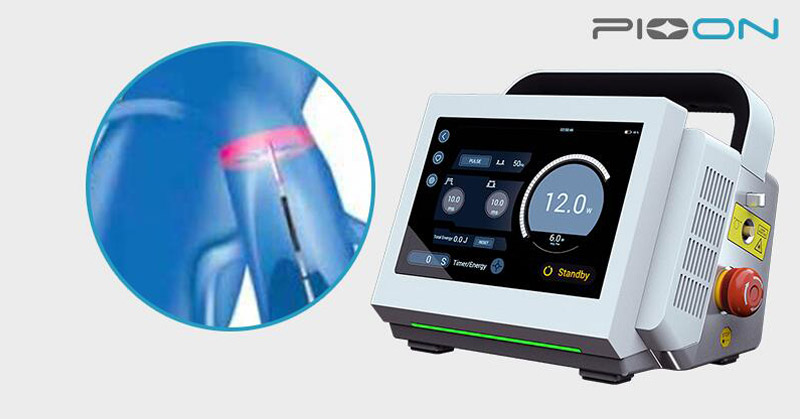
Lower Limb Varicose Veins are common and frequently occurring diseases in vascular surgery. Early performance for limb acid distension discomfort, shallow vein tortuous group, with the progress of the disease, can appear skin pruritus, pigmentation, desquamation, lipid sclerosis and even ulcer. The treatment methods of varicose veins of lower limbs include lifestyle change, drug therapy, pressure hose therapy, high ligation and saphenous vein stripping, sclerotherapy and so on. Traditional surgery has been going on for more than 100 years.
While effective, surgical ligation and stripping were associated with drawbacks such as longer recovery times, postoperative pain, and a higher risk of complications. Patients undergoing this procedure often faced a more extended healing process compared to modern alternatives like EVLA. The development of EVLA marked a significant shift in the treatment paradigm for varicose veins, offering a less invasive and more patient-friendly approach. Despite the historical prevalence of surgical interventions, the evolution toward minimally invasive procedures like EVLA has become increasingly common in the management of lower limb varicose veins.
At present, the surgery for lower limb varicose veins has tended to be minimally invasive, such as endovenous laser ablation , radiofrequency ablation, microwave therapy, etc. The traditional high ligation and dissection of the great saphenous vein are less and less used. With the development of minimally invasive techniques and the accumulation of physicians' experience, minimally invasive techniques will benefit more patients with lower extremity varicose veins and even replace traditional surgery.
The American Society for Vascular Surgery and the American Venous Forum guidelines for the Treatment of Varicose Veins of the Lower Extremity and Chronic Venous Diseases include endovenous laser ablation (ELVA) and radiofrequency ablation (RFA) as Class IB recommendations. Studies have shown that 1470nm laser with radial fiber(Radial fiber. A radial fiber emits the laser energy radially around the tip directly into the venous wall.) has fewer complications and perforation compared with traditional ablation or common laser surgery.
It is an effective method for the treatment of varicose veins of the lower extremities and one of the most ideal intraoperative methods for one-stage intravenous perforation. Compared with point laser, the ring laser output fiber can make the laser energy evenly distributed along the 360° blood vessel wall, the energy used is lower, the perforation rate is reduced, and there is no carbonization of the blood vessel wall. The absorption rate of water and hemoglobin with 1470nm wavelength is significantly higher than that of an ordinary laser, and the energy directly acts on the vascular wall, which can completely and uniformly close the blood vessels. Overall, 1470nm laser with radial fiber therapy for lower extremity varicose veins has significant advantages:
1) Rapid closure and definite curative effect.
2) Thicker trunk than radiofrequency ablation can be performed.
3) The working end of the radial fiber does not directly contact the vascular wall, and the radial annular spot exerts its ability uniformly on the vascular wall without causing carbonization.
4) More economical than other thermal closure devices.
Pioon S1Pro 1470nm diode laser stands as a clinical leader in the treatment of varicose veins, combining advanced features with a simple and compact design. The upgraded heat dissipation and refrigeration system ensure optimal energy conversion efficiency, maintaining a stable operating temperature for enhanced performance.
In combination with the radial fiber with 360° emitting light, the laser energy is directly applied to the blood vessel wall. This enables precise and direct application of laser energy to the blood vessel wall. This targeted approach significantly reduces common side effects such as ecchymosis and pain, enhancing the overall patient experience during and after the procedure.
By operating at the specific wavelength of 1470nm, the Pioon S1 Pro leverages the optimal absorption properties of water and hemoglobin, maximizing effectiveness in vascular treatments while minimizing collateral damage to surrounding tissues. This wavelength choice, combined with the unique design elements, makes the S1 Pro particularly well-suited for minimally invasive surgeries, aligning with the contemporary shift towards less intrusive interventions like Endovenous Laser Ablation (EVLA).
Ecchymosis and pain and other side effects were significantly reduced, more conducive to minimally invasive surgery.
The compact and user-friendly design of the Pioon S1 Pro Laser 1470nm not only contributes to its ease of use for healthcare professionals but also facilitates outpatient treatments. The reduced need for hospitalization and the enhanced patient comfort post-procedure further underscore the clinical advantages of the Pioon S1 Pro 1470nm diode laser in the treatment of varicose veins. In summary, its advanced features, efficient energy delivery, and minimized side effects position the S1 Pro Endolaser as a valuable tool in promoting successful and patient-friendly outcomes in the realm of vascular interventions.